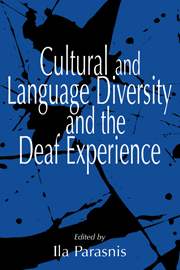Book contents
- Frontmatter
- Contents
- Preface
- PART I BILINGUALISM-BICULTURALISM AND THE DEAF EXPERIENCE: AN OVERVIEW
- 1 On Interpreting the Deaf Experience within the Context of Cultural and Language Diversity
- 2 Living with Two Languages and Two Cultures
- 3 Perspectives from the History and the Politics of Bilingualism and Bilingual Education in the United States
- 4 Cognitive and Language Development of Bilingual Children
- PART II PSYCHOSOCIAL, COGNITIVE, AND LANGUAGE EXPERIENCES OF DEAF PEOPLE
- PART III THE DEAF EXPERIENCE: PERSONAL REFLECTIONS
- Name Index
- Subject Index
4 - Cognitive and Language Development of Bilingual Children
Published online by Cambridge University Press: 05 June 2012
- Frontmatter
- Contents
- Preface
- PART I BILINGUALISM-BICULTURALISM AND THE DEAF EXPERIENCE: AN OVERVIEW
- 1 On Interpreting the Deaf Experience within the Context of Cultural and Language Diversity
- 2 Living with Two Languages and Two Cultures
- 3 Perspectives from the History and the Politics of Bilingualism and Bilingual Education in the United States
- 4 Cognitive and Language Development of Bilingual Children
- PART II PSYCHOSOCIAL, COGNITIVE, AND LANGUAGE EXPERIENCES OF DEAF PEOPLE
- PART III THE DEAF EXPERIENCE: PERSONAL REFLECTIONS
- Name Index
- Subject Index
Summary
A recent trend in the research literature on deaf signers is to view them as a cultural and ethnolinguistic minority with its own specific characteristics as compared to hearing children (see, for example, Moores, 1990). For more than two decades researchers have been interested in drawing a parallel between signed and oral language; research has shown that American Sign Language (ASL) is a fully developed linguistic system (Siple, 1978; 1982), structured as a natural language although unlike English (Lidell, 1984). Signed languages have also been described as resembling pidgins (Woodward, 1973) or Creoles (Fischer, 1978), sharing both sociolinguistic and grammatical features with these languages. Whereas there seems to be no difference in language processing when going from an oral-articulate mode to a visual-manual one (Grosjean, 1980), sign language is processed in different ways depending on whether it is acquired as a native or a non-native language (Mayberry & Fischer, 1989).
The scope of this chapter is not to draw a parallel between bilingual and deaf development. Rather, by reviewing extensively the present-day knowledge on bilingual development, we invite the reader to come to conclusions on how far this well-documented field can help us have a better understanding of the development of the deaf child. To what extent can a parallel be drawn between the signing deaf child and the hearing bilingual child? And to what degree does the signing deaf child have a unique developmental pattern distinct from his or her hearing bilingual counterpart?
Information
- Type
- Chapter
- Information
- Cultural and Language Diversity and the Deaf Experience , pp. 51 - 76Publisher: Cambridge University PressPrint publication year: 1996
Accessibility standard: Unknown
- 1
- Cited by
